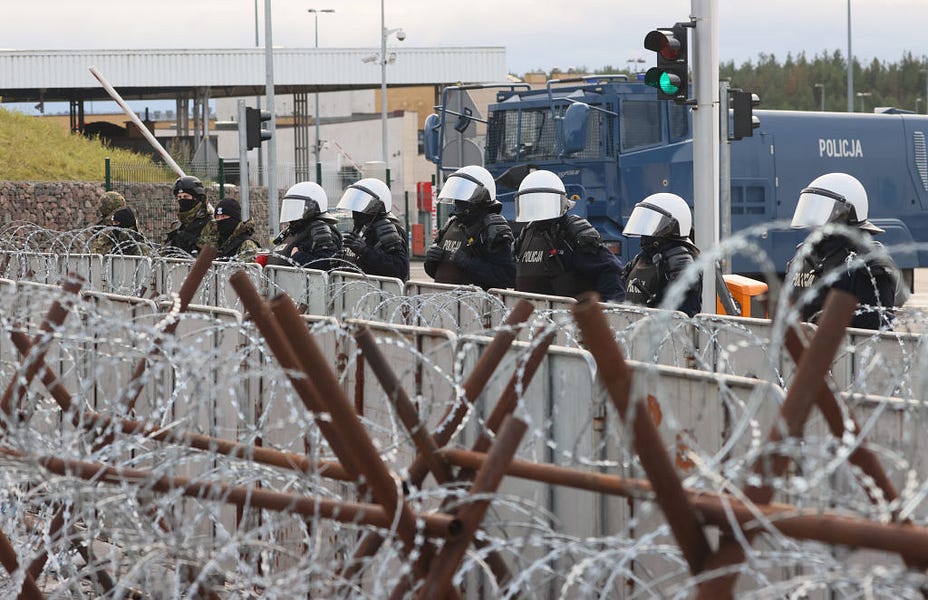Thousands of would-be asylum seekers from the Middle East have gathered at the border between Poland and Belarus since October. They did not get there on their own, and their presence is a crisis manufactured by Belarusian dictator Alexander Lukashenko for the purpose of creating tension with the European Union.
How did they end up in Belarus?
During the European migration crisis of 2015, most refugees fleeing the Middle East crossed the treacherous Mediterranean Sea on more-or-less seaworthy vessels. But in this case,people have been flown straight to Belarus courtesy of Belavia, the country’s national airline, which since just last year have introduced a number of new destinations, including Damascus, Baghdad, Ankara, and several other prominent Middle Eastern cities. It’s a cunning strategy to import people from the Middle East. After landing in Belarus, these would-be migrants have been transported to the Polish/Belarusian border, and largely left to fend for themselves (though as of November 18, some have been given temporary shelter by Belarus in abandoned warehouse buildings). Having paid dearly to get to Europe, the migrants are not keen to leave. Some have made it over the border, but most have so far been stopped in violent clashes with the Polish military.
This border, crucially, is also an external border of the EU, as Poland is a member of the EU while Belarus is not. While the migrants are attempting to cross into Poland, Germany is in fact the final destination for most of them, a country that, together with Sweden, welcomed the lion’s share of the refugees who arrived in 2015. There are virtually no border controls between EU countries. If you manage to enter one EU country, you can enter any one of them without ever having to show your passport or proof that you have a right to stay here.
Why is Belarus doing this, and what are they hoping to accomplish?
In August 2020, Lukashenko declared victory in an election that the international community widely regarded as rigged. Protests erupted as Lukashenko refused to stand down. The EU introduced tough sanctions in an attempt to force Lukashenko’s removal. Further sanctions were imposed in May 2021 after Lukashenko ordered a military jet to force down a commercial flight for the purpose of arresting dissident Roman Protasevich.What we are seeing now at the Polish border is nothing other than retaliation.
The lifting of the sanctions is, of course, the ultimate goal of this retaliation. But how would depositing a few thousand asylum seekers at the Polish border accomplish that?
Migration is a dormant, yet sensitive topic.
In 2015, more than 1 million asylum seekers made their way to Europe. This created a humanitarian crisis as countries struggled to house and feed the asylum seekers, while at the same time processing their applications in an orderly manner (and making sure they did not disappear into the shadows). Crime spiked, most infamously on New Year’s Eve when a series of mass assaults took place in Germany and several other countries. The wave receded only after the EU made a deal with Turkey, effectively bribing the country to stop the would-be asylum seekers from crossing into Europe. Turkey has since then frequently threatened to break the deal and unleash millions of asylum seekers onto Europe again, and these threats have left the EU more or less paralyzed and unable to confront the increasingly totalitarian Erdogan regime.
Migration flows have ebbed since 2015, which has had the effect of tempering support for some of the more radical anti-immigration parties.
The scenes of asylum seekers struggling with border police and military have caused fears that Belarus may be able to artificially create a repeat of 2015. Whether the country is truly capable of that is a different question; what matters is that, by flying in migrants looking to seek asylum in the EU, Belarus is deepening the divisions that migration has already caused.
Tensions are high between Poland and the rest of the EU
Poland is presently defending the external border of the EU on its own, and that is adding to existing tensions with the EU. As far as Poland is concerned, these asylum seekers are not their problem since Poland is just a pass-through for those who want to seek asylum in Germany and other Western European countries. Fom Poland’s perspective, they are selflessly protecting other countries from an onslaught of asylum seekers, at no real benefit but at a great cost to themselves.
As a member of the EU, Poland has frequently marched out of step with the other member nations, on everything from LGBT rights to climate change. Poland is heavily reliant on coal, and the EU has insisted the country wean itself of this dependence. While Poland agrees in principle, they want to go far slower than the EU would like. In September, the EU imposed fines of 500,000 euros a day for Poland’s refusal to shut down a coal mine that supplies a plant that generates 7 percent of the country’s electricity. Poland has refused to pay.
Suddenly, in a twist of events, the EU finds itself having to rely on Poland. Belarus is no doubt hoping that it can create further tension.
What makes matters worse is that no-one doubts that Russia and the Putin regime are the brains behind this plan, and that the target is Germany. For the second time in less than a century, Poland has become merely a brick in a realpolitik game between Germany and Russia. The analogy may not be obvious to Westerners, but in Poland, these scars and memories still run deep.
On paper, defending the border is everyone’s responsibility.
The EU, like NATO, has a mutual defense clause obligating member states to help one another if one of them is attacked. But what counts as attacked? Poland would argue that Belarus is engaging in hybrid warfare and that other countries ought to contribute money and troops to protect the Polish border. So far, only the U.K.–which is of course no longer an EU member– has committed actual troops.
In many ways, this is a test to see whether EU countries are actually willing to defend one another, a commitment that has never truly been tested. Does it take a declaration of war before a country can demand help from another member state? Who decides when an attack or a situation is dire enough that other member states have an obligation to help out? No one really knows.
Poland has the EU’s support – for now.
When the border crisis began, Poland had the unanimous support of the European Union. It did not, however, take long for U.N. officials and others to make statements about how the EU has to do something to aid the migrants, and the media pumped out stories on the horrible conditions and how migrants were freezing to death. Rarely is it mentioned that these migrants came willingly to a non-EU country that offered to help them sneak into the EU, where they intended to claim asylum not in the first country where they arrived, but rather in Germany or another country known for generous social safety nets. While Belarus has since put up many of the asylum seekers in warehouses, the harsh conditions and images of clashes with border control will no doubt lead to more people blaming Poland for not admitting them. And Poland is acutely aware of this, having seen how western Europe allowed itself to be engulfed in a sea of asylum seekers six years ago by basing policy on emotions rather than long-term thinking.
It’s important to understand the EU’s asylum process and how it’s being abused in this case. The Dublin convention, agreed by all EU member states, dictates that asylum seekers musto apply for asylum in the first EU country that they enter. They are not allowed to “pick and choose” which country they shelter in. If would-be asylees apply in a country other than the one they first entered,, the country they apply in has the right to send them back to the first country and ask them to process the claim.
This, however, was not how it went down in 2015, nor for all that matters since then. Virtually all the refugees who come to Germany and the other Western European countries travel through other, poorer EU countries in the east or south of Europe. Western countries have mostly turned a blind eye, especially as it’s difficult to prove which specific country someone entered through, and thus difficult to prove which country should be responsible for providing asylum (if the application is granted).
Since 2015 nearly broke the system in several western European countries, these same countries have pushed for an EU-wide reallocation of asylum seekers. Eastern European countries have always had a more restrictive view on asylum migration, and countries like Germany and Sweden have attempted to force them to take more refugees. How this would work in practice no one knows: There is no plan for how to forcibly round up hundreds of thousands of refugees and put them on planes or trucks heading to Poland and Hungary. There is also no plan to make sure they stay there, as they would of course be able to move around the borderless EU and would almost certainly show up on Germany’s or Sweden’s doorstep again.
That is why it is crucial for Poland to prevent anyone from crossing the border: Legally, these asylum seekers would be Poland’s responsibility and, if Germany and other countries felt like actually applying the Dublin convention, Poland would have to process their claims and host them. Even if they don’t press the Dublin convention claim, Germany could threaten to do so in order to get Poland to agree to a reallocation of refugees.Finally, Poland may doubt the support of especially Germany as the country has become increasingly reliant on Russian gas since abandoning nuclear power. This gas flows through Belarus, meaning Lukashenko can actually turn off the tap, as he threatened just over a week ago to do. This threat was followed by some “unscheduled maintenance” that restricted oil flows from Belarus to Poland for three days.
What should the EU do?
Lukashenko has declared that he is willing to negotiate, suggesting the EU might just take some of the asylum seekers. That is a trap. If the EU, or any of its member states, were to agree to take a single asylum seeker, it would legitimize the strategy Belarus is employing. This “operation” by Belarus and Russia must be seen as a test of a new form of hybrid warfare. If deemed successful, it will be used again in the future, and at a greater scale. The mere threat that it may be deployed again will hamper the EU’s ability to act against Russia and Belarus when necessary.
In addition to turning away the asylum seekers and reimbursing Poland for the cost of protecting the border, the EU must immediately issue additional sanctions against Belarus and Russia for these actions. The union must send the message that while it may have a soft spot for refugees, it has none for the totalitarian regimes that would weaponize people willing to do anything for a chance to seek a better life.






Please note that we at The Dispatch hold ourselves, our work, and our commenters to a higher standard than other places on the internet. We welcome comments that foster genuine debate or discussion—including comments critical of us or our work—but responses that include ad hominem attacks on fellow Dispatch members or are intended to stoke fear and anger may be moderated.
With your membership, you only have the ability to comment on The Morning Dispatch articles. Consider upgrading to join the conversation everywhere.